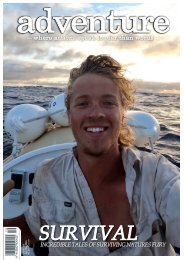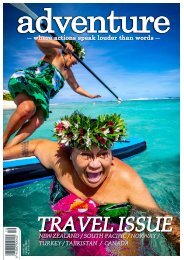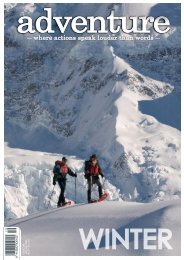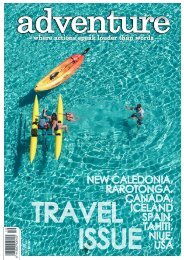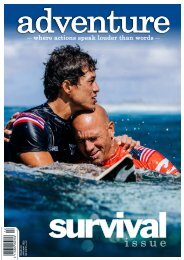Create successful ePaper yourself
Turn your PDF publications into a flip-book with our unique Google optimized e-Paper software.
The following day we were up early and<br />
paddled out to Nuulopa Island in the<br />
half-light to watch the flying foxes return<br />
to roost on this tiny, uninhabited tooth of<br />
an island that had once been part of a<br />
volcano rim. The bats forage overnight<br />
on the plentiful papaya and other tropical<br />
fruits of the main islands before returning<br />
to crowded roosting trees which are<br />
overhanging the sea. Here they fight and<br />
squabble noisily for a branch from which<br />
to hang and sleep the day away. Our<br />
attention was divided between the bats<br />
and the spectacular orange sunrise that<br />
sparkled off the water around Manono.<br />
That afternoon we snorkelled through<br />
a colony of giant clams in Le Faga Bay.<br />
These fluorescent molluscs are almost a<br />
metre long and located in a sheltered area<br />
less than 100 metres from shore. With a<br />
water temperature more like that of a tepid<br />
bath, we inevitably left the water only once<br />
we were too wrinkled as we were never<br />
going to be too cold.<br />
By day 5, we had had several adventures<br />
outside the reef, including visiting<br />
Nuusafee Island. Landing there involved<br />
negotiating the reef entrance. A few of our<br />
group in their kayaks decided to surf small<br />
reefs on the way. The sense of being alone<br />
in paradise was intense as we swam in the<br />
lagoon and picnicked on the white sand<br />
beach.<br />
For most of us, the highlight of the trip<br />
was Namua Island. To get there, we had<br />
taken an unusual route, paddling from the<br />
beachside resort of Lalomanu around the<br />
outside of Nuutele Island. We had to be<br />
careful as there was a metre-high swell<br />
running with a significant chop created<br />
from the backwash off the island. You<br />
never know what you might see in this<br />
tranquil, unspoilt water; out of the blue<br />
(literally), someone spotted a whale spout<br />
a few hundred metres away, and as we<br />
watched it, from a different direction a<br />
fine blubbery-smelling mist drifted over<br />
us from another whale that had breached<br />
unnoticed right beside us. September<br />
and October are the peak months when<br />
humpback whales (tafolā) visit Samoa, but<br />
you can often see them all year round.<br />
The only habitation on Namua is a small<br />
collection of Beach Fales on the sandy<br />
beach in a wilderness paradise. The island<br />
rears up behind the coast, providing a lofty<br />
lookout for whales and dolphins in the bay<br />
and is a convenient base for exploring the<br />
nearby islands. From here, we kayaked<br />
across to Fanuatapu Island, where we had<br />
recently found and cleared a track to the<br />
small lighthouse. From the lighthouse, we<br />
watched frigate birds in aerial dog fights<br />
with other tropical birds. The frigate birds<br />
have no protective oil in their feathers and<br />
so get most of their food by stealing it on<br />
the wing off other species.<br />
Lesa, the 13-year-old daughter of the<br />
proprietor of the Namua resort, suggested<br />
we attempt a walk around the outside of<br />
the island. "It is easy enough at low tide<br />
if the sea is moderate." Then she added,<br />
"Don't tell my dad, but we got swept off the<br />
rocks one day."<br />
That was just the incentive we needed,<br />
and we spent the next hour clambering<br />
around. Fortunately, it was a relatively<br />
calm sea so we could enjoy the island’s<br />
wild side. We were admiring the walking<br />
fish on the rocks, the boobies circling<br />
overhead to the backdrop of the crashing<br />
surf.<br />
Towards the end of our trip, we paddled<br />
to Nuutele Island. Entering the deep<br />
water outside the reef entrance, we were<br />
surprised by a giant turtle just resting<br />
on the surface. Too big to be worried<br />
by our presence, he looked at us lazily<br />
before slowly swimming away. An<br />
escort of swooping gannets and petrels<br />
accompanied us as we approached the<br />
island.<br />
Nuutele island was once home to a leper<br />
colony, and it seemed that sea conditions<br />
might be calm enough for us to land. A<br />
narrow channel had been blasted through<br />
an inner reef, and we took turns running<br />
the gauntlet to crash onto the shore of<br />
rounded coral boulders in a very wet<br />
landing. The colony's ruins were mute<br />
testimony to how brutal life before penicillin<br />
was. The foundations were littered with<br />
coconut shells tossed there by big swells,<br />
and the only water supply was a trickle<br />
down a rock face.<br />
Under a Samoan setting sun, we were<br />
being fanned by the warm tropical breeze<br />
as we had each day of the trip. We<br />
finished back at our cottage with a meal<br />
of seared premium masimasi tuna steaks<br />
and a local ribeye steak with green papaya<br />
salad. And inevitably, we planned the next<br />
trip over one too many Vailima beers and<br />
glasses of fine New Zealand wine.<br />
Outdoor Samoa have safely run bike and<br />
kayak tours in Samoa for 14 years. With<br />
a fleet of over 100 bikes and 20 modern<br />
sea kayaks they provide 9-day all inclusive<br />
tours from $1,750 NZD.<br />
Contact Ross and Frances at:<br />
office@outdoor.co.nz to organise<br />
a custom tour or join a group.<br />
Outdoorsamoa.com<br />
78//WHERE ACTIONS SPEAK LOUDER THAN WORDS/#233



